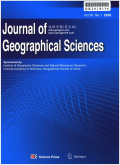- 钛学术文献服务平台 \
- 学术期刊 \
- 基础科学期刊 \
- 天文学、地球科学期刊 \
- 地理学报(英文版)期刊 \
Quantification of human and climate contributions to multi-dimensional hydrological alterations:A case study in the Upper Minjiang River,China
Quantification of human and climate contributions to multi-dimensional hydrological alterations:A case study in the Upper Minjiang River,China
基本信息来源于合作网站,原文需代理用户跳转至来源网站获取
摘要:
Dual factors of climate and human on the hydrological process are reflected not only in changes in the spatiotemporal distribution of water resource amounts but also in the various characteristics of river flow regimes.Isolating and quantifying their contributions to these hydrological alterations helps us to comprehensively understand the response mecha-nism and patterns of hydrological process to the two kinds of factors.Here we develop a general framework using hydrological model and 33 indicators to describe hydrological pro-cess and quantify the impact from climate and human.And we select the Upper Minjiang River (UMR) as a case to explore its feasibility.The results indicate that our approach suc-cessfully recognizes the characteristics of river flow regimes in different scenarios and quan-titatively separates the climate and human contributions to multi-dimensional hydrological alterations.Among these indicators,26 of 33 indicators decrease over the past half-century(1961-2012) in the UMR,with change rates ranging from 1.3% to 33.2%,and the human impacts are the dominant factor affecting hydrological processes,with an average relative contribution rate of 58.6%.Climate change causes an increase in most indicators,with an average relative contribution rate of 41.4%.Specifically,changes in precipitation and reservoir operation may play a considerable role in inducing these alterations.The findings in this study help us better understand the response mechanism of hydrological process under changing environment and is conducive to climate change adaptation,water resource planning and ecological construction.

推荐文章
Sulfate sources constrained by sulfur and oxygen isotopic compositions in the upper reaches of the X
Sulfur isotope
Oxygen isotope
Riverine sulfate
Carbonate weathering
Xijiang River
Elemental characteristics and paleoenvironment reconstruction: a case study of the Triassic lacustri
Trace elements
Occurrence mode
Paleoenvironment
Zhangjiatan oil shale
Yanchang Formation
Ordos Basin
Variations of trace elements under hydrological conditions in the Min River, Eastern Tibetan Plateau
Trace elements
Concentration-discharge relationship
Tibetan Plateau
River
Hydrodynamic characteristics of Wujiangdu Reservoir during the dry season—a case study of a canyon r
Canyon reservoir
Hydrodynamic characteristics
A transition zone
Wujiang River
内容分析
关键词云
关键词热度
相关文献总数
(/次)
(/年)
引文网络
引文网络
二级参考文献 (119)
共引文献 (130)
参考文献 (51)
节点文献
引证文献 (0)
同被引文献 (0)
二级引证文献 (0)
1963(1)
- 参考文献(0)
- 二级参考文献(1)
1970(1)
- 参考文献(1)
- 二级参考文献(0)
1971(2)
- 参考文献(0)
- 二级参考文献(2)
1973(1)
- 参考文献(0)
- 二级参考文献(1)
1978(2)
- 参考文献(0)
- 二级参考文献(2)
1979(1)
- 参考文献(0)
- 二级参考文献(1)
1981(1)
- 参考文献(0)
- 二级参考文献(1)
1983(1)
- 参考文献(0)
- 二级参考文献(1)
1984(1)
- 参考文献(0)
- 二级参考文献(1)
1986(1)
- 参考文献(0)
- 二级参考文献(1)
1989(2)
- 参考文献(0)
- 二级参考文献(2)
1990(2)
- 参考文献(0)
- 二级参考文献(2)
1991(3)
- 参考文献(1)
- 二级参考文献(2)
1993(2)
- 参考文献(0)
- 二级参考文献(2)
1994(1)
- 参考文献(0)
- 二级参考文献(1)
1996(5)
- 参考文献(1)
- 二级参考文献(4)
1997(4)
- 参考文献(0)
- 二级参考文献(4)
1998(3)
- 参考文献(0)
- 二级参考文献(3)
1999(7)
- 参考文献(1)
- 二级参考文献(6)
2000(5)
- 参考文献(0)
- 二级参考文献(5)
2001(2)
- 参考文献(0)
- 二级参考文献(2)
2002(6)
- 参考文献(1)
- 二级参考文献(5)
2003(6)
- 参考文献(2)
- 二级参考文献(4)
2004(6)
- 参考文献(2)
- 二级参考文献(4)
2005(9)
- 参考文献(2)
- 二级参考文献(7)
2006(5)
- 参考文献(2)
- 二级参考文献(3)
2008(8)
- 参考文献(3)
- 二级参考文献(5)
2009(6)
- 参考文献(1)
- 二级参考文献(5)
2010(9)
- 参考文献(4)
- 二级参考文献(5)
2011(7)
- 参考文献(1)
- 二级参考文献(6)
2012(10)
- 参考文献(4)
- 二级参考文献(6)
2013(7)
- 参考文献(2)
- 二级参考文献(5)
2014(10)
- 参考文献(3)
- 二级参考文献(7)
2015(7)
- 参考文献(1)
- 二级参考文献(6)
2016(8)
- 参考文献(3)
- 二级参考文献(5)
2017(11)
- 参考文献(9)
- 二级参考文献(2)
2018(3)
- 参考文献(3)
- 二级参考文献(0)
2019(3)
- 参考文献(3)
- 二级参考文献(0)
2020(1)
- 参考文献(1)
- 二级参考文献(0)
2021(0)
- 参考文献(0)
- 二级参考文献(0)
- 引证文献(0)
- 二级引证文献(0)
引文网络交叉学科
相关学者/机构
期刊影响力
地理学报(英文版)
主办单位:
中国地理学会
中国科学院地理科学与资源研究所
出版周期:
月刊
ISSN:
1009-637X
CN:
11-4546/P
开本:
16开
出版地:
北京安外大屯路甲11号
邮发代号:
创刊时间:
1990
语种:
eng
出版文献量(篇)
1776
总下载数(次)
1
总被引数(次)
12509
期刊文献
相关文献
推荐文献
- 期刊分类
- 期刊(年)
- 期刊(期)
- 期刊推荐
力学
化学
地球物理学
地质学
基础科学综合
大学学报
天文学
天文学、地球科学
数学
气象学
海洋学
物理学
生物学
生物科学
自然地理学和测绘学
自然科学总论
自然科学理论与方法
资源科学
非线性科学与系统科学
地理学报(英文版)2022
地理学报(英文版)2021
地理学报(英文版)2020
地理学报(英文版)2019
地理学报(英文版)2018
地理学报(英文版)2017
地理学报(英文版)2016
地理学报(英文版)2015
地理学报(英文版)2014
地理学报(英文版)2013
地理学报(英文版)2012
地理学报(英文版)2011
地理学报(英文版)2010
地理学报(英文版)2009
地理学报(英文版)2008
地理学报(英文版)2007
地理学报(英文版)2006
地理学报(英文版)2005
地理学报(英文版)2004
地理学报(英文版)2003
地理学报(英文版)2002
地理学报(英文版)2001
地理学报(英文版)2021年第9期
地理学报(英文版)2021年第8期
地理学报(英文版)2021年第7期
地理学报(英文版)2021年第6期
地理学报(英文版)2021年第5期
地理学报(英文版)2021年第4期
地理学报(英文版)2021年第3期
地理学报(英文版)2021年第2期
地理学报(英文版)2021年第1期

 免费查重
免费查重










